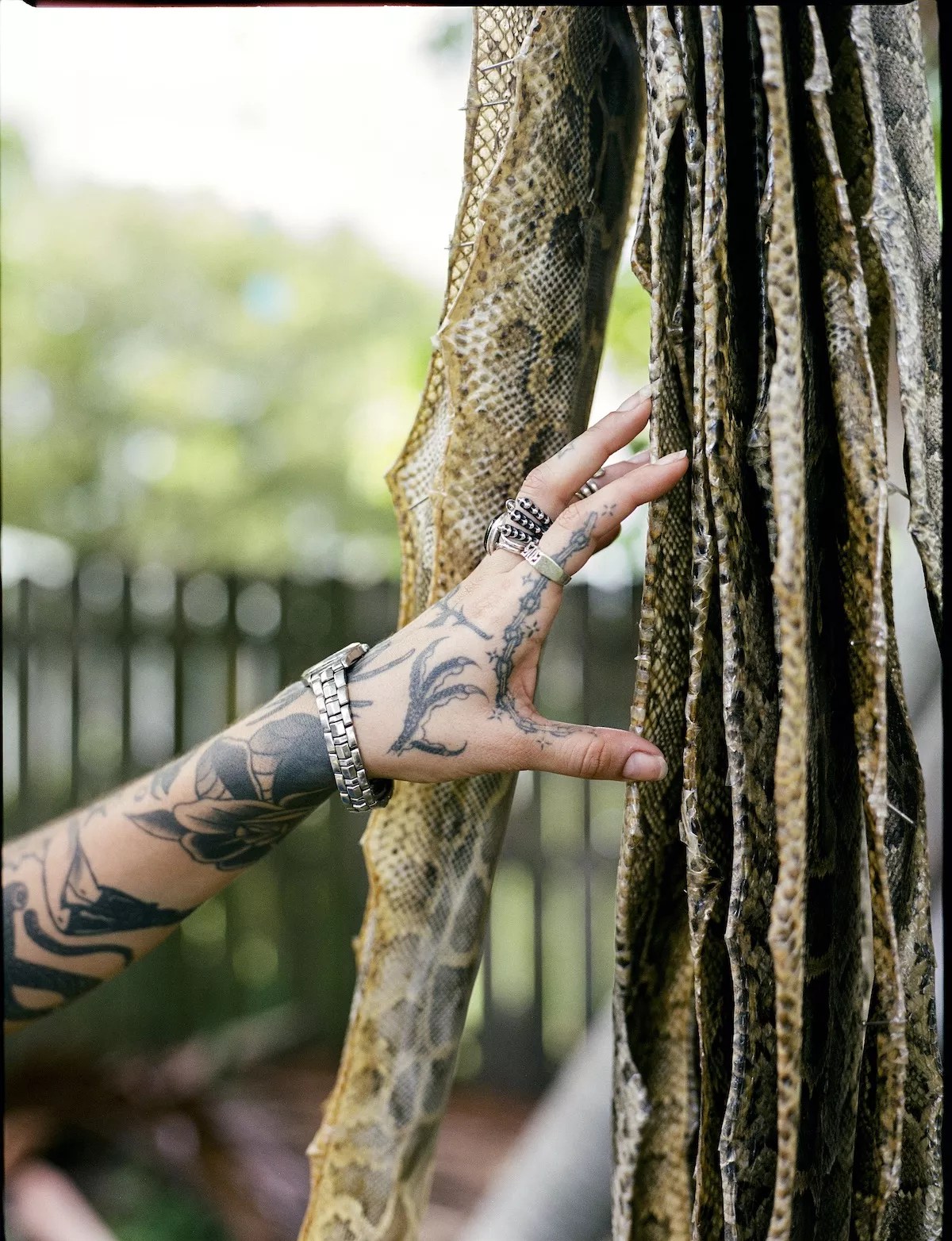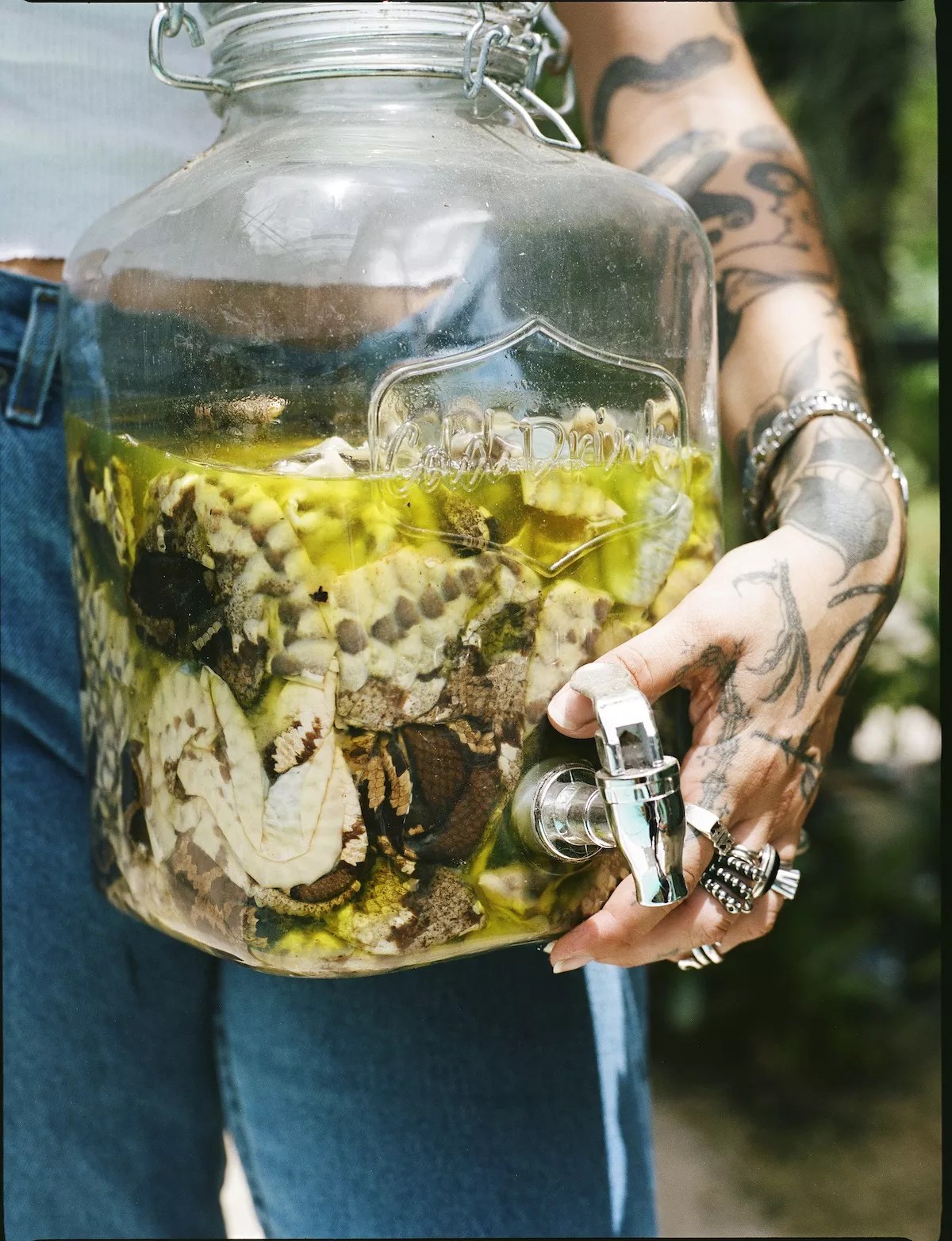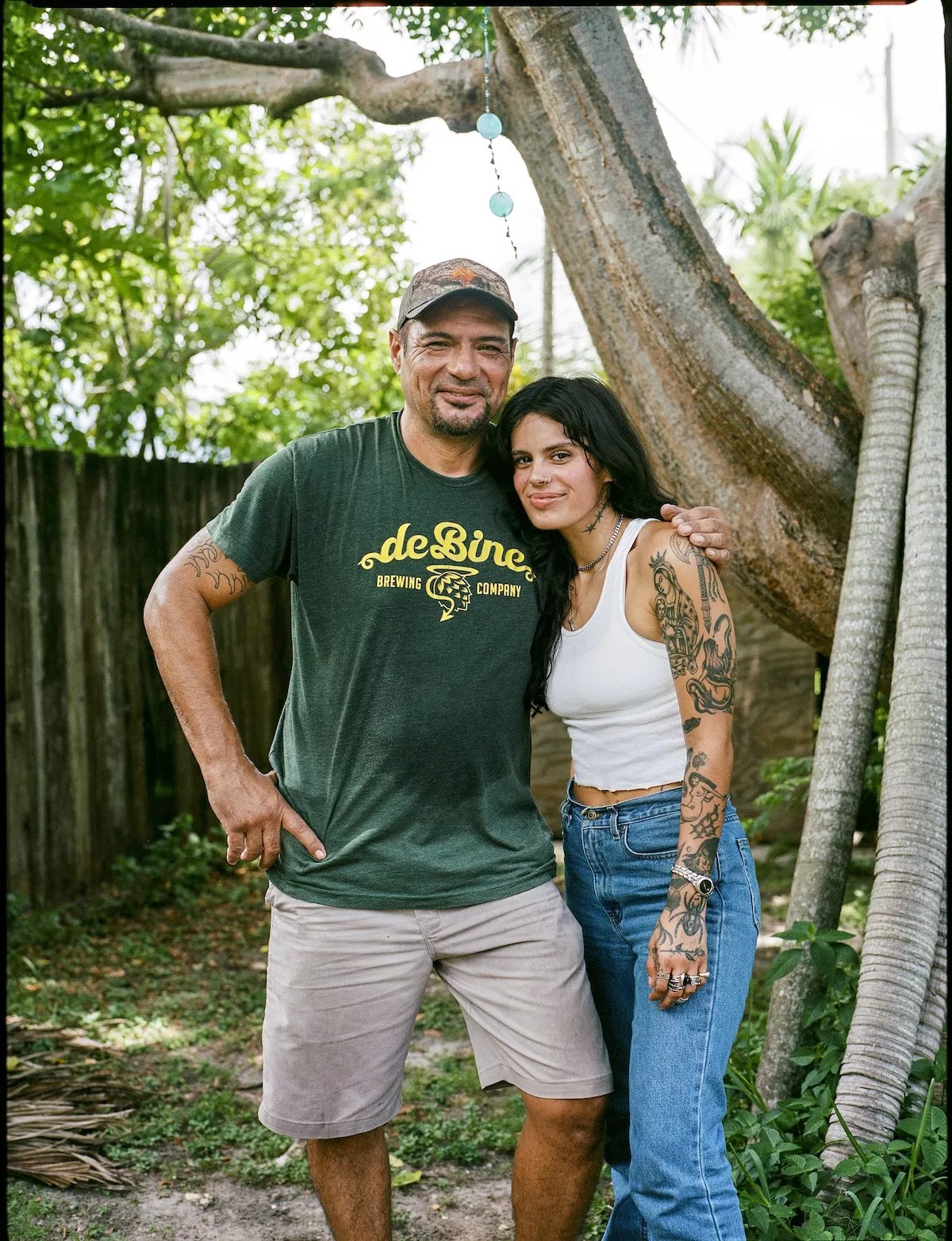
Photo by Ysa Pérez

Audio By Carbonatix
On a muggy summer evening, Elle Barbeito‘s gaze lands on a blur of grass and cypress trees as she cruises down a dirt road in the Everglades. She pulls her black hair into her teal tie-dye hoodie to silence the crooning frogs and humming mosquitoes – when hunting for Burmese pythons, she can’t afford any distractions. She rides in the back seat of python hunter Brian Hargrove’s pickup truck with her head tilted out the window like a self-described lagartija relajada (relaxed iguana). Riding shotgun with Hargrove is his hunting partner and longtime best friend, Mark Yon – Barbeito’s father, whom she endearingly refers to as “Skunk Ape.” For them, it’s just another worknight.
A few miles in, Hargrove stops the truck to give space to a hunter ahead; it’s not polite to trail. As Yon admires the stars, Barbeito surveys the marsh. She flashes a light across the pitch-black water to reveal dozens of glowing red orbs skimming the surface just a few feet away.
“Those are all alligators,” she says, having exposed the gator congregation. “My eye’s gotten a lot better from doing this,” she adds before climbing back into the truck to continue the pursuit.
The trio cruises through Big Cypress National Preserve as reggae plays from the truck’s speakers. Clad in her comfiest denim, Doc Martens, and a hoodie she designed with an alligator guard dog logo, Barbeito scans the dark swamp with a flashlight in a trance. When her eye catches a subtle difference in the pattern of the grass, Hargrove abruptly stops the car. This time it’s just a water snake.
The team is tasked with capturing and removing Burmese pythons as part of the South Florida Water Management District’s Python Elimination Program to control the invasive snake population that’s annihilating the Everglades’ native wildlife. With no predators of its own, not even the American alligator, the Burmese python, with its voracious appetite, consumes most of the Everglades native mammals – including raccoons, marsh rabbits, and possums – and is now encroaching on wading birds and other species. The snake is an elusive and skilled hunter, growing up to 26 feet in length and capable of reproducing at an alarming rate.
“It’s not the snake’s fault [that it’s here],” Barbeito says. “But they’re still destroying the food chain, and [hunting them] is the only way.”

Python skins hang to dry.
Photo by Ysa Pérez
To the untrained eye, it’s hard to discern the creeping and the crawling in the dark sawgrass marsh. But the artist, fashion designer, and assistant python hunter knows that if you look closely enough at the base of trees or in the swampy trenches, you may catch a glimpse of the python’s iridescent light and dark brown blotches.
Barbeito is hunting for invasive pythons that she’ll later skin to create sustainable fashion and functional art. Her latest collection, which is inspired by utilitarianism camouflage and exudes a swamp-cowboy-meets-goth aesthetic, serves as a homage to the snake she has spent years pursuing.
“You have to have a lot of respect for nature,” Barbeito says. “I definitely feel a spiritual connection with the snakes.”
During successful hunts, Hargrove photographs each live snake as proof for the state program, collects it, and stows it in a bag with its fellow twisting captives. At the end of the night, he’ll reluctantly kill them one by one with a small handgun, shooting the creatures in the head. For him, it’s the worst part of the night.
“I couldn’t [euthanize them] right away because it would just ruin my state of mind, you know?” Hargrove explains. “When you see them, it’s really something. It’s a special moment when you find one, and you kind of want to relive that and remember it as long as possible.”
“As artists, we need to make sure everything we make is solving the problem instead of creating it.”
Hargrove and Yon, longtime friends and herping enthusiasts, have always deeply revered snakes. As South Florida teenagers they’d spend their free time catching and releasing snakes and other reptiles. They helped the state capture more than 12,000 snakes. The South Florida Water Management District pays $10 an hour, up to ten hours, with bonuses depending on the length of the snake. It’s an additional $50 for the first four feet and $25 for every foot thereafter. Hunters who catch pythons that were guarding eggs can collect an extra $200. A female Burmese python may lay up to 100 eggs between March and May. By early summertime, hunters are on the lookout for hatchlings.
Most nights, Hargrove and Yon ride in silence except for their playlist. They’re sensible and respect the snakes they capture and euthanize, a reverence they’ve passed down to Barbeito, whom they call their “good luck charm.”
“My dad drilled this in my head: We have to make sure that every single part of the snake is utilized, otherwise we’re just killing the snake and it’s wasteful,” Barbeito says. “As artists, we need to make sure everything we make is solving the problem instead of creating it.”

Barbeito’s curing concoction of glycerin, alcohol, and Florida water.
Photo by Ysa Pérez
From Invasive Python to Utilitarian Fabric
Barbeito was born and raised in South Florida, shuttling between her grandmother’s home in West Kendall and her father’s in Cutler Bay. Sandwiched in suburbia, the Everglades and the freedom they offer were simply part of her upbringing.
“There’s nowhere else like the Everglades in the world,” she says.
Barbeito’s mother enrolled her in art classes when she was 5, and her creativity was always encouraged. For high school, Barbeito attended New World School of the Arts, where a sculpture teacher informed her that everything she was making out of wood and otherwise unconventional materials could be worn: She was making wearable sculptures – or fashion.
For one project, a 15-year-old Barbeito attempted to re-create out of wood an Alexander McQueen armadillo boot that was made famous in Lady Gaga’s “Bad Romance” music video. Though she never finished the sculpture, that summer she attended the Savage Beauty exhibition at the Metropolitan Museum of Art, which honored the late McQueen’s romantically gothic and evocative designs.
“It was just amazing to be able to see his pieces in person, and I remember from that day on, I was just like, yeah, this is what I want to do,” Barbeito says of the trip to New York. “It was such an intense experience.”
Barbeito’s current inspirations include Bárbara Sánchez-Kane and Kym Ellery, two Australian designers with sculptural and minimalist aesthetics. Sánchez-Kane infuses Mexican lifestyle commentary into her work, and it’s that same relationship between garment and place that has driven Barbeito’s most recent work with pythons.
After studying fashion for two years at the Pratt Institute in New York City and working in the industry, Barbeito realized she needed a reset. She was apprehensive about moving back to Miami owing to the relative lack of opportunities in fashion, but she returned anyway.
“Florida is such a special place,” she explains. “It got to a point where I felt lost, and I was floating around and I needed to go home.”
In the midst of formulating her transition to Miami in 2017, Barbeito received a text message from her father saying he’d gone hunting the night before with Hargrove. He invited her to join them the next time she was in town. She asked him what his plans were for the skins, and everything clicked.
“He gave me one of the skins, and from there I was just trying to figure out how to work with it,” she says.
Snakeskin was a completely new medium for Barbeito. Hargrove and Yon taught her the laborious process of skinning, curing, and stretching the skin. She taught herself intricate leatherwork by watching YouTube videos.
“Everything in the Everglades seems like one big image until you start looking closer.”
Barbeito has always had a fond appreciation for utilitarian fabrics like denim. But she’d never thought of working with leather. For her, fashion should serve a purpose; otherwise, it is just adding to an already wasteful industry.
“The intention is utility above everything,” she says. “The last thing we need is more things, or more pretty things to look at. We need things that are intentional, that are going to help us and help our daily lives, and help the environment that we’re in too.”
Barbeito sees clothes as a tool that can be created to fulfill a necessity, especially with respect to hunting and sport. In 2020, she first explored camouflage through the “swamp suit” she created for her show at Superchief Gallery in Miami. She took a photo in the Everglades and printed it onto fabric. Python hunting had begun to infiltrate her subconscious, and she couldn’t stop thinking about the snakes hidden in the environment.
“I was trying to re-create that,” she says. “Everything in the Everglades seems like one big image until you start looking closer, and then there’s this creature, there’s this bird, so it was this idea of taking a closer look and being a part of it.”
Many of the pieces in her latest collection continue the hunting or camouflage theme. During a clay pigeon shooting trip in Orlando, she was given a pouch to hold the shotgun ammo and she thought: I could make this. She did, creating a skeleton vest with an ammo bag styled as a reimagined ghillie suit, a traditional camouflage ensemble that mimics foliage used by hunters and military personnel. Recently, she’s added micro handbags and coin purses to her collection.
Barbeito is asked frequently why she can’t just return the snakes to their native habitat in Southeast Asia, where the species is classified by the World Conservation Union as “near threatened” owing to exportation for the pet trade and hunting for skins.
She is quick to retort that doing so would introduce a host of ecological concerns, including the potential to introduce bacteria and disease.
According to the U.S. Fish and Wildlife Service, approximately 99,000 Burmese pythons were imported to the United States between 1996 and 2006, compared to only 17,000 between 1970 and 1995. Thousands of pythons are also captive-bred each year in the U.S. for sale as pets. Burmese pythons sell at reptile trade shows for as little as $20 and at pet stores for $65 to $80. An inexperienced snake keeper who takes home a 20-inch hatchling is, within a year, responsible for a hefty eight-foot apex predator.
Unable to handle the giant snakes, some owners illegally release them into the wild, where the pythons have repopulated at an alarming rate, resulting in dire consequences for native wildlife and ecosystems in South Florida. The extinction of native mammals could have a trickle-down effect on the food chain, affecting flowering plants and the entire fabric of the Everglades.

Artist Elle Barbeito and her father, Mark Yon.
Photo by Ysa Pérez
A Death, and a Cleansing Ritual
At Yon’s Cutler Bay home, Barbeito’s jade-green 1990 Ford Bronco is stationed outside like a protective watchdog over their suburban home. Her father’s front yard is a native gardener’s dream. Pine rockland plants line the doorway, with coontie, firebush, and wild coffee attracting a flutter of native butterflies and bees. In an instant, atalas, a butterfly species that was on the verge of extinction, flits between plants, eagerly taking its pick of nectar. For Yon and Barbeito, hunting and gardening are equally important facets of their commitment to wildlife conservation.
The backyard reeks of a wet dog as the two skin their largest capture yet: a 16-footer. Barbeito straddles a motorcycle backward, with a plank of wood balanced precariously atop the back tire. She and Yon spend hours painstakingly separating the skin from its flesh with a razor, then scraping it until it’s clean. Once they’re done, they’ll steep the skin in a bucket of glycerin, alcohol, and orange-scented Florida water to cure. Days later, they’ll lay it out to dry on a wood plank for days, hoping the rain doesn’t interrupt the process.
As he hammers the damp skin to the wood, Yon recounts his experiences hunting, celebrating the snake’s intelligence and the unnerving nature of his job. On one occasion, he recalls being preoccupied with a ten-foot python. When he turned around, he saw another ten-footer standing four feet high behind him in a posture called periscoping. The snake was analyzing him like potential prey. Once the reptile gathered enough information to realize he could not eat Yon, it attempted to escape.
“I thought it was fake at first,” Yon says.
In her bedroom studio, two snakeskins are curing in jars. In another area, dried snakeskins drape over hangers. Papery thin in texture, they sometimes shed scales when rubbed. “The scales really make it feel super alive,” she says.
Perhaps the most important and recurrent step in Barbeito’s process is a ritual to honor the snake’s spirit.
Her room serves as a showroom of her collection and a workstation where she diligently crafts her pieces. It was her skill at handiwork and sewing and meticulous technique that caught the eye of a product developer at Kanye’s West’s lifestyle brand Yeezy who hired her to work as a design assistant for the Season 8 collection. She is able to manipulate the snakeskin and troubleshoot different ways of piecing it together. When worn, her pieces feel as strong as armor, yet sleek. But perhaps the most important and recurrent step in Barbeito’s process with the skins is a ritual to honor the snake’s spirit.
Barbeito hangs the skins in her closet with incense lit underneath to mask the scent. For her, the process reflects a cleansing ritual.
“My dad has always said it’s bad nature karma for him. He’s like, ‘Oh I want to make sure Mother Earth is not pissed off at me,'” she explains. “I definitely agree.”
Hanging on the wall is a tapestry of a skeletal goddess hovering atop an open-jawed gator with a halo of flames and fairies. The traditional style of the tapestry, which she bought from a New Orleans tattoo artist, mirrors her own tattoos. It’s reminiscent of Kali, the Hindu goddess of time, creation, and the destruction of evil. Barbeito channels this energy of creation and destruction effortlessly – destroying what is harmful to the land and creating something practical out of the demise. It is a fragile balance that she straddles.
Traditionally, snakes have been symbols of rebirth and transformation; when a snake sheds a skin through sloughing, its body renews itself. As Barbeito’s garments go out into the world, adorning their wearers, a piece of the Everglades goes with them, a second life for the python, and a hopeful prayer for regeneration.